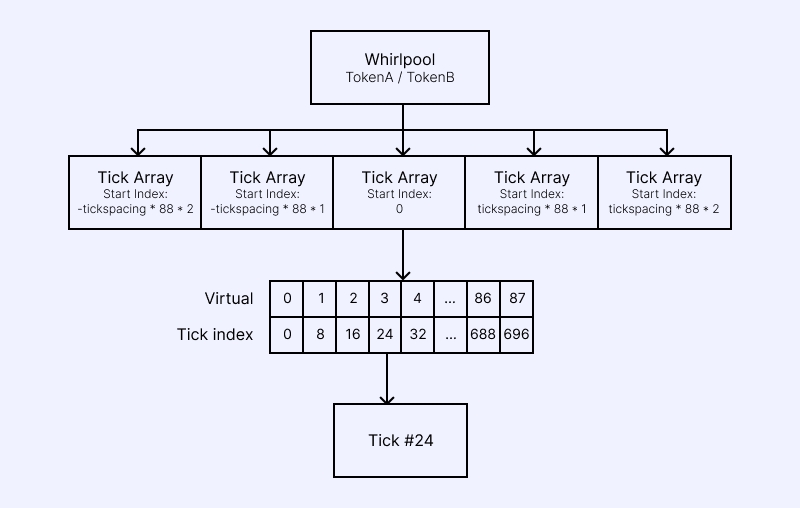Understanding Tick Arrays

A sequence of ticks are stored in individual tick-array accounts on chain. Each whirlpool has a sequence of tick-array accounts to host the entire tick range.
A tick-array is keyed by the start-index of its hosted ticks and can hold 88 physical ticks in an array. It only hosts the tick objects for the initializable tick indices based on the Whirlpool's tick-spacing. The total range for a tick-array is therefore 88 * tick-spacing.
Tick Array Account Info
- Number of physical tick slots - 88
- Account Size - 10kb
Usage in Whirlpool Program Instructions
When you interact with ticks on Whirlpool instructions, often you will need to derive the correct tick-array so the program can get access to the designated tick object. This tick-array is a PDA derived using the Whirlpool pool’s public key and the start tick index of the tick array, which defines the beginning of a specific range of ticks.
For example, if the current tick is 200, the tick spacing is 2, and each tick-array contains 88 ticks, you can compute the start tick index by first finding the closest multiple of tick_spacing * ticks_per_array that is less than or equal to the current tick. Here, the start tick index would be 176, calculated as (200 // (2 * 88)) * (2 * 88).
Open Position
When a position opens up in a new tick or price range, the tick-array must be initialized before the position can be created. This means the user invoking the position will need to cover the rent-exempt cost for the tick-array account, which is 10 KB in size.
Once a tick-array account is set up, it cannot be closed and will never need to be reinitialized. For this reason, Whirlpool owners may consider preemptively initializing tick-array ranges to prevent unexpected costs for users.
Adjust Liquidity (increase / decrease liquidity)
Users of these instructions must provide the tick-arrays that contain the specified tick indexes. For each instruction, two tick-arrays need to be passed in—these may be the same array if the range is small. The instruction requires access to these accounts to read the appropriate Tick objects effectively.
Swap
Swap users will have to provide the series of tick-arrays that the swap will traverse across.
The first tick-array in the sequence typically houses the Whirlpool's current tick index, though this is not always required.
The second and third tick arrays are the next tick-arrays in the swap direction. If the user knows the swap will not traverse to the next tick-array, or it's simply not possible at both ends of the price range, they can just put in any tick-array public key.
In some cases, such as with the new swap instruction, users can pass in up to six tick-arrays, with only three arrays being crossed during a swap. For example, the Whirlpools SDK preemptively provides the tick-array containing the current price, along with two arrays below and two above it, ensuring adequate coverage for different price ranges.